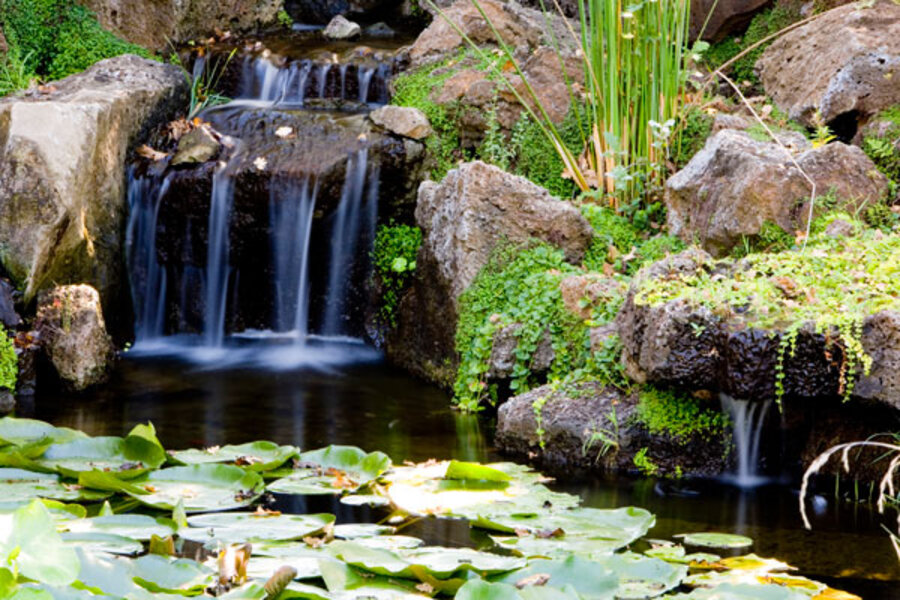Five tips for creating natural-looking waterfalls
Loading...
What makes one backyard waterfall look as though it’s been pouring over the rocks for centuries, and another look like cement blobs were thrown at a hillside? I wrote about naturalistic rock placement in another posting, but today let’s look at falling water.
In my ongoing search for how to re-create the natural look in gardens, I turn to one of my favorite waterfall builders — Gerald Roulette, of G & O Landscaping in Sherwood, Ore. You can use Gerald’s tips when planning your own waterfall — whether you want a charming trickle or mighty stream.
Every garden benefits from the addition of water, and now’s the time to think about what you want once spring arrives, either DIY or with a builder.
Gerald tells me he looks to nature for his inspiration. “You never see anything in the wild that resembles a retaining wall,” he says. So he often spends his time hiking up streams to Oregon’s ubiquitous waterfalls.
1. Consider the source. In nature, even the most thundering falls can have modest beginnings. The source of Oregon’s crashing Metolius River shows itself first as a series of springs that emerge from a mossy bank at the base of arid Black Butte — quite a subject of contemplation when you realize how dramatic the water becomes on its downward journey.
TIP: Create a naturalistic start. Many garden falls are constructed with biological filter boxes at the top. These need to be hidden by rocks and surrounding plants —leaving plenty of access for maintenance — or constructed to resemble a still pool, as if water is arising from a wellspring.
2. Stories in stones. All flowing water carries a history of how the stream formed. For instance, Gerald studies the sharper rock edges on a falls, where the earth has been scoured away by the rushing water, revealing the underlying slabs, often tilted at the same angle. He notes, “In any falls, the water is exposing the rocks, making them appear as if they are coming out of the ground.”
TIP: Bury your spill rocks. Plan on seriously hiding large parts of the rock that make up your falls. You want the stone to look as if it’s emerging from the earth, all at a similar angle, not plopped on top.
3. Erratic behavior. Other falls in nature are completely made up of rounded rocks, tumbled for eons by water and glacial action. In the wild places, such as the Cascade Mountains or even New York’s Central Park, you’ll find dramatic house-size boulders called “erratics,” rounded and rubbed by long-gone glaciers, often deposited far from where they were originally formed.
TIP: Ground your boulders. Trying to reproduce erratic placement in your backyard tends to look spotty-dotty. If you like the high-mountain look, tuck plants and smaller rocks around large rocks to help them fit in. The accompanying rock garden-type plants appreciate the extra drainage these planting pockets afford.
4. Water works. Streams move straight downhill in steeper areas, stopped only by rocks that form pools. The area under a falls is dug out by the force of the stream, pushing smaller pebbles up to the outer edges.
TIP: Place the deepest part of your pool under the falls. If you have a drain, that’s where it should be. Arrange the basin’s pebbles so they curve up to the surrounding rocks and plants.
5. Sounds, not silence. When you go to see waterfalls in nature, don’t forget to listen. Try to determine what makes the water’s various notes. A cascade pouring off a ledge resonates differently from one trickling around large rocks. Water splashing into a deep pool can be distinguished from water hitting partly submerged stones.
TIP: Avoid “Niagara syndrome.” That’s the term artists George Little and David Lewis shared with me to define, as David puts it, “Too much volume of water in too small an area, without considering the intimacy of the site.” Installing a pump that allows for flow control solves the problem.
Mary-Kate Mackey is one of eight garden writers who blog regularly at Diggin' It. She is co-author of “Sunset’s Secret Gardens — 153 Design Tips from the Pros” and contributor to the “Sunset Western Garden Book,” writes a monthly column for the Hartley Greenhouse webpage and numerous articles for Fine Gardening, Sunset, and other magazines. She teaches at the University of Oregon’s School of Journalism & Communication. She writes about water in the garden for Diggin’ It.
Editor’s note: To read more by Mary-Kate, click here. The Diggin' It blog archive has everyone's posts (scroll down]. The Monitor’s main gardening page offers articles on many gardening topics. See also our RSS feed. You may want to visit Gardening With the Monitor on Flickr. If you join the group (it’s free), you can upload your garden photos and enter our next contest.





